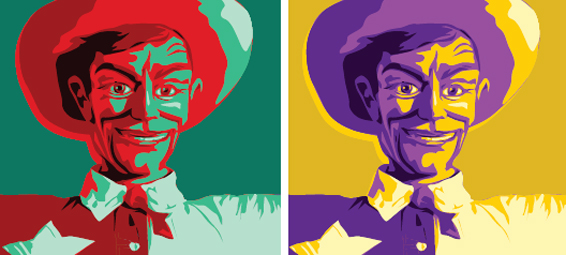Dallas’ most beloved and well-known public sculpture spectacularly burst into flames on the morning of October 19, 2012. Big Tex, the gangly, goofy-looking cowboy with the animated grin and the crackling-speaker voice, fell victim to a short circuit of the jaw. Just as his waving hand and avuncular banter were the product of a simple carnival trick, so, too, his demise—the carny equivalent of a sliced jugular.
You couldn’t have scripted Tex’s end more sensationally. Cellphone cameras captured the soot-black smoke plume rising from his melting head. In YouTube videos, you can hear horrified gasps punctuating an eerie silence. The entire ordeal looked like a Viking send-off to a kitschy Americana figure—buttoned-up Big Tex playing Burning Man. Obituaries were written, flowers laid at the foot of the charred frame. And, in the end, Big Tex was offered a fitting Dallas tribute. “We’ll rebuild him and make him better than ever for the 21st century,” proclaimed Mayor Mike Rawlings. This Friday, when the State Fair of Texas opens, Big Tex will indeed be back. Just how much bigger and in what way better are closely guarded secrets. There were no media previews for this rebirth.
One way of gauging the value of a work of art is to note how well it illuminates the people and the place that establish its context. In this way, while Big Tex himself may not exactly be considered a great work of art, his conflagration was. The outpouring of affection that followed the Big Tex bonfire revealed a potent relationship so many people felt toward the personified figure. Big Tex was a conduit for the nostalgic feelings conjured by the arrival of the fair each fall, to the way festivals, like all communal rituals, both mark the passing of time and firmly ground our memories in it. And his death and rebirth are indicative of the figure’s convoluted history.
Big Tex’s origins lie less with the Old West and more with the entrepreneurial gumption of Texas’ small towns, the salesmanship that is the real backbone of the state’s growth and character. Tex began his life as a 49-foot-tall Santa Claus on Colket Avenue, in the tiny town of Kerens, Texas, where the local chamber of commerce placed him in 1949 in an effort to drum up holiday shopping sales. He was purchased in 1951 for the State Fair by future Dallas mayor R.L. Thornton, and the artist Jack Bridges was commissioned to turn Santa Claus into a cowboy. Bridges created a face for Tex that blended three models: a real-life rancher named Doc Simmons, the entertainer Will Rogers, and Bridges himself, thus injecting into Big Tex’s DNA a flavor of the Old West with a hefty dose of vaudeville theatricality.
By the time Dallas salesman Roger Reynolds brought Big Tex to Minnesota in 1953 to represent Texas at a national convention of the Junior Chamber of Commerce, Tex was no longer selling ladies’ hosiery but an idea of Texas itself. Tex became a larger-than-life totem remade in the image of the friendly cowboy.
If Big Tex showed up in the barrel vault of the Dallas Museum of Art, you might mistake him for a new work by Jeff Koons or Paul McCarthy. Tex belongs to the source material that inspires both artists, who use kitsch to challenge the art world’s aesthetic principles. Since Andy Warhol, the byproducts of American pop culture have been adopted and manipulated by artists to explore the underbelly of the seemingly benign visual language of advertising. Big Tex is likewise a manipulated figure of consumerism, a manufactured icon that branded the State Fair and, by extension, the state itself. But what makes Big Tex different from high art appropriations of popular culture is the figure’s and its creators’ complete lack of irony. Irony infuses the art of Koons, McCarthy, and others with self-awareness, allowing so-called “bad taste” to be simultaneously indulged in and critiqued. With Tex, however, there’s a distinct sense that those selling a sentimentalized version of Texas’ cowboy identity believed their own pitch.
Big Tex is nothing if not a paean to sincerity. He is a hokey, sentimental sort, all “Howdy, folks!” and “Be careful, kids.” That Big Tex looks like a cross between a cartoon cowboy and a creepy circus clown is part of the low-tech simplicity that connects him to midcentury America, to an era whose optimism, idealism, and infatuation with a glamorized myth of the American cowboy have since eroded into a culture defined by irony. But the day that Tex erupted into a pillar of fire, we saw that many still connect deeply with Big Tex’s simple sincerity.
That’s why lovers of Big Tex shouldn’t fear the plans to make him bigger and better. Such promises only underscore a continuity of the aspirational spirit shared by Big Tex’s original creators and our current-day civic leaders. But the wider public’s love of Big Tex is not so one-dimensional. The radio traffic from Dallas Fire-Rescue dispatch from the morning Big Tex burned to a crisp quickly made its way to YouTube. It is a mix of melancholy and wisecracks.
“Engine 6 out, Big Tex on fire,” says a clearly dejected voice, quickly followed by another voice:
“Howdy, folks. It’s hot.”
Illustration by Daniel Hertzberg




